Charles Sturt University facts for kids
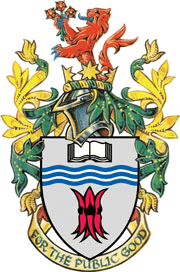
|
|
|
Former name
|
List
|
|---|---|
| Motto | For the public good |
| Type | Public research university |
| Established |
|
| Accreditation | TEQSA |
|
Academic affiliations
|
|
| Budget | A$571.02 million (2023) |
| Visitor | Governor of New South Wales (ex officio) |
| Chancellor | Michele Allan |
| Vice-Chancellor | Renée Leon |
|
Academic staff
|
821 (FTE, 2023) |
|
Administrative staff
|
1,266 (FTE, 2023) |
|
Total staff
|
2,087 (FTE, 2023) |
| Students | 34,894 (2023) |
| Location | , |
| Campus | Urban and regional with multiple sites |
| Named after | Charles Sturt |
| Colours | Ochre |
|
Sporting affiliations
|
|
| Mascot | Charlie the Cockatoo |
| Website | csu.edu.au |
 |
|
Charles Sturt University is a big public university in Australia. It has many campuses in New South Wales, the Australian Capital Territory, and Victoria. The university started in 1989. It was named after Captain Charles Sturt. He was a British explorer who explored parts of New South Wales and South Australia.
It is the largest university in regional Australia. It offers many different courses. It also works with various partners across the country.
Contents
History of Charles Sturt University
The university officially began on 1 July 1989. It was formed by joining several smaller colleges. These colleges were called Colleges of Advanced Education.
Some of these colleges included:
- Mitchell College of Advanced Education in Bathurst.
- Riverina-Murray Institute of Higher Education in Albury-Wodonga and Wagga Wagga.
The Riverina College of Advanced Education started in 1972. It was formed from Wagga Teachers' College. Later, it joined with Wagga Agricultural College in 1976. Wagga Teachers' College began in 1947. Wagga Agricultural College opened in 1949.
Bathurst Teachers' College opened in 1951. It was built on the site of the Bathurst Experiment Farm. This farm started in 1895. After Bathurst Teachers' College closed in 1967, Mitchell College of Advanced Education opened in 1970.
Goulburn Teachers’ College opened in 1970. It became a college of advanced education in 1974. In 1982, it became part of the Riverina College. Later, in 1984, its staff and students moved to the Albury and Wagga campuses. A new Police Academy was then built on the Goulburn campus.
Charles Sturt University opened study centres in Sydney in 1998 and Melbourne in 2007. These centres were run by a private group. The university ended this partnership on 31 December 2022. Courses at the Sydney and Melbourne locations are now being phased out.
In 1998, the Goulburn campus was set up. It teaches policing to the New South Wales Police.
The Dubbo campus started in 1999. The university also began working with four universities in China.
On 1 January 2005, Charles Sturt took over its Orange campus. This campus was originally the Orange Agricultural College. It started in 1973. It joined Charles Sturt University to continue its focus on agriculture.
From 2005 to 2015, the university had a campus in Burlington, Ontario, Canada. This campus closed in July 2015.
In 2005, Charles Sturt started offering veterinary science degrees. This helped with the shortage of veterinarians in rural areas. In 2008, the university also began offering dentistry courses. This led to new dental clinics in regional areas.
On 14 February 2011, Charles Sturt University updated its logo. The Sturt's desert pea flower became a main part of the design.
On 1 May 2012, a new campus opened in Port Macquarie. This was the university's first campus on the coast. It made higher education easier to access for people in that region.
In 2013, the university started using a special power plant. This plant helps save fuel costs and reduce carbon emissions.
On 18 April 2016, staff and students moved into the new Port Macquarie campus. The second part of this campus was finished in 2020. It included training rooms for emergency services and student support areas. The university plans for 5,000 students at this campus by 2030.
On 28 July 2016, Charles Sturt became Australia's First Official Carbon Neutral University. This means it balances out its carbon emissions.
On 9 May 2018, Charles Sturt and Western Sydney University announced a partnership. They created the Murray-Darling Medical School. This program trains doctors in the Murray-Darling Basin region.
In May 2019, for its 30th anniversary, the university launched a new look. This included a new crest. The crest uses colours and patterns inspired by First Nation culture. It also shows the landscapes of regional New South Wales.
On 29 May 2019, Charles Sturt University joined the Regional Universities Network (RUN). It became the seventh member of this group.
In March 2021, the first medical students started at the Orange campus. This is part of the Joint Program in Medicine with Western Sydney University. The program aims to train doctors for rural and regional areas.
In 2022, the Riverina College of Advanced Education celebrated its 50th Anniversary. This event included a reception and a preview of a new book about the college's history.
Campuses and Buildings
Charles Sturt University has six main campuses. These are in Albury-Wodonga, Bathurst, Dubbo, Orange, Port Macquarie, and Wagga Wagga.
Albury–Wodonga Campus
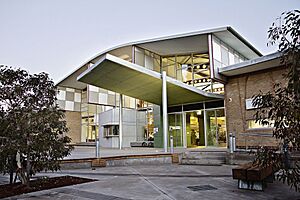
The Albury-Wodonga campus is located on the border of New South Wales and Victoria. This campus focuses on environmental science, education, business, and health courses.
Campus features:
- Labs for anatomy and physiology.
- A centre for community health.
- A Herbarium (a collection of preserved plants).
- Wetlands for environmental studies.
Bathurst Campus
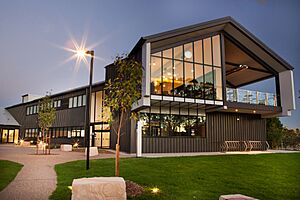
The Bathurst campus offers degrees in engineering, communication, education, law, and many health fields. These include paramedicine and exercise science.
Campus features:
- Labs for biochemistry, exercise science, nursing, and paramedicine.
- A clinic for dental and oral health.
- Engineering labs and facilities.
- A media centre and the 2MCE radio station.
- Television studios and editing suites.
Dubbo Campus
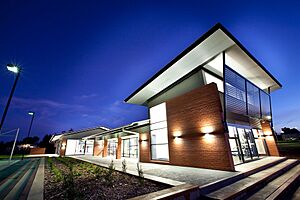
The Dubbo campus offers social work, nursing, and preparation courses. It focuses on providing education to First Nations students.
Campus features:
- A nursing and clinical lab.
- A dental and oral health clinic.
- An interactive learning centre.
Orange Campus

The Orange campus focuses on allied health, medical sciences, dentistry, medicine, and pharmacy courses.
Campus features:
- Medical learning facilities, including an anatomy lab and simulation hospital wards.
- Labs for chemistry, pharmacy, and physiotherapy.
- A dental and oral health clinic.
Port Macquarie Campus
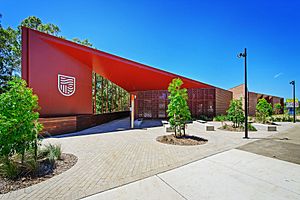
The Port Macquarie campus is the university's newest campus. It is also its first campus located on the coast.
Campus features:
- A paramedicine simulation clinic.
- Medical imaging and nursing labs.
- Anatomy and physiology labs.
- Practical learning rooms for occupational therapy and physiotherapy.
- Facilities for Sport and Exercise Science.
Wagga Wagga Campus

The Wagga Wagga campus is north of the Murrumbidgee River. It is the university's main centre for agriculture and sciences. It covers a large area of 640 hectares. Students can study animal and veterinary sciences, education, business, health, and IT here.
Campus features:
- The National Life Sciences Hub.
- Veterinary science clinics and labs.
- A farm and equine (horse) centre.
- A commercial winery.
- A dental and oral health clinic.
Other Study Locations
- A centre in Goulburn for students studying policing.
- A Regional University Study Centre in Wangaratta for combined TAFE and university study.
- Study locations in Canberra and Parramatta for students studying theology.
How Charles Sturt University is Run
University Council
Charles Sturt University is managed by a Council with 16 members. The Chancellor and vice-chancellor are part of this Council. Dr. Michele Allan is the current Chancellor. She has been in this role since 2014. Professor Renée Leon became the Vice-Chancellor in 2021.
Faculties and Departments
Charles Sturt University has three main faculties. Each faculty offers many courses and study areas. Each faculty also has different schools and centres for specific subjects:
- Faculty of Arts and Education
- Faculty of Business, Justice and Behavioural Sciences
- Faculty of Science and Health
Faculty of Arts and Education
This faculty includes schools and centres like:
- Centre for Islamic Studies and Civilisation
- School of Education
- School of Indigenous Australian Studies
- School of Information and Communication Studies
- School of Social Work and Arts
- School of Theology
Faculty of Business, Justice and Behavioural Sciences
This faculty offers courses in business, justice, and behavioural sciences. The justice side covers policing, security, and law. The behavioural science side offers psychology courses. Schools and centres include:
- Australian Graduate School of Policing and Security
- Centre for Customs and Excise Studies
- Centre for Law and Justice
- School of Business
- School of Computing, Mathematics and Engineering
- School of Policing Studies
- School of Psychology
Faculty of Science and Health
This science faculty is one of the largest in Australia and New Zealand. Schools include:
- School of Agricultural, Environmental and Veterinary Sciences
- School of Allied Health, Exercise and Sports Sciences
- School of Dentistry and Medical Sciences
- School of Nursing, Paramedicine and Healthcare Sciences
- School of Rural Medicine
Coat of Arms
The university has a special design called a coat of arms. It was given to the university in 1989. The colours green and gold come from Captain Charles Sturt's family. The red lion and three roses are also from his family's design. The three roses represent the three original university cities: Albury-Wodonga, Bathurst, and Wagga Wagga.
The gold stars are for Australia. A flower called Swainsona formosa (Sturt's Desert Pea) is also on the design. This flower was seen by Charles Sturt during his explorations. The three blue wavy lines represent rivers. They show that the first campuses were near rivers. The open book stands for learning. The university's motto, "For The Public Good," is also on the coat of arms. This motto comes from a quote by Charles Sturt himself.
Academic Information
Libraries and Databases
Charles Sturt University has libraries at its main campuses. These libraries offer many resources. You can find eBooks, online journals, encyclopedias, and videos. They also provide online workshops and guides to help students.
University Rankings
Universities are often ranked to show how good they are. Here's how Charles Sturt University has been ranked:
- Australian Rankings
In the Australian Financial Review Best Universities Ranking for 2024, Charles Sturt University was ranked 39th among Australian universities.
- Global Rankings
- In the 2026 Quacquarelli Symonds World University Rankings, the university was ranked between 951st and 1000th globally. It was 34th in Australia.
- In the Times Higher Education World University Rankings for 2025, it was ranked between 801st and 1000th globally. It was 37th in Australia.
- In the 2024 Academic Ranking of World Universities, the university was ranked between 901st and 1000th globally. It was 31st in Australia.
- In the 2025–2026 U.S. News & World Report Best Global Universities, it was ranked 864th globally. It was 32nd in Australia.
Student Success
The Australian Government surveys students to see how they do. These surveys look at student experience, job outcomes, and how happy employers are with graduates.
- In 2023, employers were very happy with Charles Sturt graduates. The satisfaction rate was 85.8%.
- In 2023, 91.2% of undergraduate students found full-time jobs after graduating. For postgraduate students, this was 93.4%.
- The starting salary for undergraduates was about AUD$75,700. For postgraduates, it was about AUD$106,000.
- In 2023, undergraduate students rated their overall education experience at 77.1%. Postgraduate students rated theirs at 78.6%.
Student Life
Student Senate
Students at Charles Sturt University have a group that represents them. It's called the Charles Sturt University Student Senate. This group includes different student committees from each campus:
- Orange Student Representative Committee (OSRC)
- Murray Campus Council (MCC) for Albury Campus
- Bathurst Student Representative Committee (Bathurst SRC)
- Dubbo Student Representative Committee (DSRC)
- Rivcoll Student Representative Committee (Rivcoll SRC) for Wagga Wagga campus
- Port Student Representative Committee (Port SRC) for Port Macquarie campus
- Online Study Student Representative Committee (OS SRC) for online students
Sports and Athletics
The Charles Sturt University Football Club in Bathurst started in 1963. It is one of the oldest football clubs in Bathurst. Its name changed over time to match the university's name.
Student Newspaper
Hungappa is a student newspaper at Charles Sturt University. It started in 1989. The name "Hungappa" means "to spread the word" in the language of the local Aboriginal tribe, the Wiradjuri.
Notable People
Many well-known people have studied at Charles Sturt University. These include TV presenters like Andrew Denton, Amanda Keller, Latika Bourke, and Hamish Macdonald. Leslie Weston, a scientist, became a Fellow of the Australian Academy of Science in 2023. Craig Steven Wright also has several degrees from Charles Sturt University.
See also
- List of universities in Australia
- Centre for Applied Philosophy and Public Ethics
- St Mark's National Theological Centre

